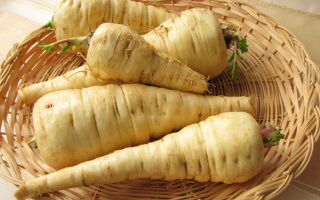Content
- 1 What does parsnip look like and where does it grow?
- 2 Chemical composition of parsnip
- 3 Nutritional value and calorie content of parsnips
- 4 Why parsnips are good for you
- 5 Weight loss benefits of parsnips
- 6 Parsnip-based medicines
- 7 The use of parsnips in traditional medicine
- 8 Parsnip in dermatology and cosmetology
- 9 The use of the root and leaves in cooking
- 10 Parsnip harm and contraindications
- 11 Harvesting and storage of useful culture
- 12 Conclusion
- 13 Reviews
Parsnip is a root vegetable with an unusual sweetish taste and pleasant smell. The peculiarity of the taste characteristics of this vegetable is also indicated by its other name - field borscht. Due to the abundance of useful properties, it is used in cooking, folk medicine, and cosmetology. The benefits and harms of parsnips are a question that specialists in medicine and dietetics are studying: their findings will be useful to everyone who monitors their health and nutrition.
What does parsnip look like and where does it grow?
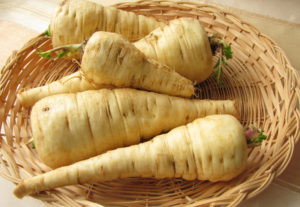
Parsnip is a vegetable, root vegetable that belongs to the Umbrella family. It is also popularly known under the names "white root", "white carrot", and, in addition, it is famous for its irreplaceable beneficial properties, thanks to which it has firmly taken its place in the recipes of traditional medicine.
The aerial part of the plant reaches a height of up to two meters. The stem is straight, branches at the top, and long leaves of large sizes are located on thin branches. Parsnip flowers are collected in complex umbrellas and are yellow in color.
The fruits of this culture are represented by greenish-yellow achenes. When ripe, the fruit is divided into two: each contains one seed.
The underground part of the plant is a cream-colored cone-shaped root vegetable that looks like a carrot. The size of the root crop ranges from 12 to 25 cm.
The vegetable tastes sweet, with a specific nutty flavor.
The historical homeland of parsnip is the Caucasus, its population is widespread in Europe, Asia, America.
Chemical composition of parsnip
The health benefits of parsnips are due to its rich chemical composition, which gives it a wide range of valuable properties.
The root vegetable is saturated with the following elements:
- magnesium;
- calcium;
- sodium;
- manganese;
- potassium;
- selenium;
- zinc;
- copper;
- phosphorus;
- iron;
- vitamin C;
- vitamin K;
- almost B vitamins.
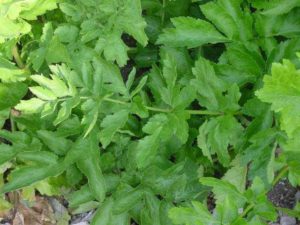
In addition, parsnips include: fiber, pantothenic acid, folates, antioxidants.
Due to the multicomponent chemical composition, high concentration of essential oils and useful biologically active components, this vegetable tuber is able to activate the endocrine glands and regulate the body's metabolism.
Nutritional value and calorie content of parsnips
100 g of fresh parsnips contain:
- proteins - 1.2 g;
- fats - 0.30 g;
- carbohydrates - 17.9 g.
The calorie content of the product is 75 kcal per 100 g.
Why parsnips are good for you
The low calorie content of parsnips is significantly offset by its beneficial properties, in particular:
- high in sulfur and siliconthat affects the strength of the nails;
- the presence of chlorine and phosphorus, useful for the respiratory tract and therefore giving invaluable benefits to people suffering from lung diseases;
- high percentage of potassium, which benefits the activity of the brain, increasing its activity.
Impact on digestion
Parsnip contains a variety of essential oils, which are the reason for its specific taste. The benefit of the latter is that they cause active secretion of gastric juice. It works to increase appetite and speed up the digestion of food.
Another valuable property - low calorie content - makes it possible for those wishing to lose weight to consume this vegetable without harming the figure.
Effects on hormonal levels
The hormonal benefits of parsnips have also been studied extensively. Biologically active substances affect the production of enzymes, which, in turn, affect the production of certain hormones.
Due to its positive effect on hormones, field borscht tones the body, increasing overall performance.
Benefits for the kidneys

In the process of metabolism, parsnip has another useful property: it helps to accelerate the excretion of urine, thereby maintaining the health of the organs of the urinary system and kidneys.
The ingredients in this vegetable help dissolve calculi and prevent harmful reabsorption of urine.
Means from parsnips are used as an element of complex therapy for inflammatory processes: cystitis, diseases of the urinary and gall bladders. The benefits of parsnips for men are to speed up the process of treating prostatitis.
Effects on the respiratory system
The beneficial properties of parsnip root also include a positive effect on the respiratory system.
This vegetable contains a large amount of vitamin C and carotene, which together increase immunity and reduce the risk of developing inflammatory processes.
And the benefits of parsnip root are also invaluable for patients suffering from tuberculosis or asthma, as well as in helping with emphysema.
Weight loss benefits of parsnips
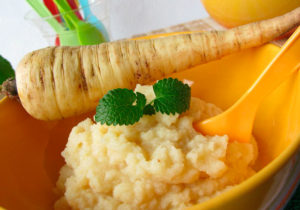
Since parsnips are not high in calories, they can be consumed without harm to the figure. The substances contained in the vegetable activate metabolic processes in the body, which gives it a unique property - the ability to accelerate the breakdown of fats.
In addition, the diuretic property of parsnips helps to remove excess fluid from the body.
Parsnip-based medicines
Parsnip is well represented in the pharmaceutical market in the form of medicines.
They are made on the basis of useful extracts from the plant - furocoumarins.
The healing white root is found in medicines such as:
- Beroxan. This parsnip preparation is used to treat vitiligo and other dermatological conditions. In addition, Beroxan will be beneficial in the treatment of extensive baldness;
- Pastinacin. It is produced in tablets that have an antispasmodic effect. They are also used for coronary insufficiency and angina pectoris.
The use of parsnips in traditional medicine
A useful root vegetable is widely represented in traditional medicine recipes, since it is used in the treatment of various diseases.
The juice
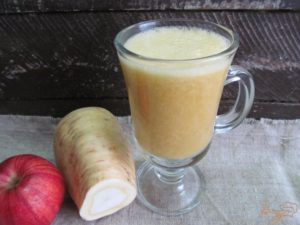
To make parsnip juice, all you have to do is cut the carefully washed root vegetable into cubes and place them in a juicer.
Freshly squeezed juice has the following beneficial properties:
- helps to eliminate bad breath;
- increases appetite;
- removes phlegm;
- as part of complex therapy, it fights infectious processes;
- reduces the acidity of gastric juice;
- has choleretic and diuretic effects.
To get the benefits you need, it is recommended that you take 1 to 2 teaspoons of the juice 30 minutes before a meal.
Decoction of parsnip leaves
The use of parsnip leaves is widely practiced by traditional medicine specialists. The most common recipe is a decoction based on them.
To prepare the broth, you need to take a tablespoon of dry plant leaves and pour them with a liter of water. Put on fire, boil for half an hour, then strain and leave in a warm place for a day. Take a tablespoon three times a day.
Useful properties of the broth: the ability to remove stones and sand from the organs of the urinary system and treat kidney stone disease.
Decoction of parsnip roots
To prepare a decoction of the parsnip root, you need to grate the fresh root vegetable with a grater. Take 2 tablespoons of the resulting mass, sprinkle with 5 tablespoons of sugar and pour a glass of boiling water.
Let the liquid brew for 10 days. Take 2 tablespoons 5 times a day.
The benefits of such a decoction of white root are associated with its ability to effectively fight colds and coughs.
Tea with parsnips

The healing properties of parsnip leaves are manifested in the tea prepared on their basis.
To do this, you need to grind the dried leaves. Add the same amount of linden and a tablespoon of natural honey to 3 tablespoons of the resulting mass. Pour everything with a liter of boiling water.
Let the tea brew for half an hour. It is useful to take a glass of the drink 2-3 times a day instead of regular tea. However, you should not get carried away with the drink, so as not to get the opposite effect, since an increase in the recommended dose increases the concentration of active substances and can be harmful to health.
Useful properties of the resulting tea:
- beneficial effect on the nervous system;
- sedative effect;
- tonic effect.
Infusion of parsnips
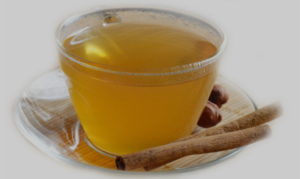
To prepare a useful tincture, you need to take a large tuber, chop it, put it in a jar, tamping it so that its particles release juice. Pour half a liter of vodka over the mass.
Leave the mass for a month in a dark place, while it is necessary to periodically stir and shake the contents of the container. Take three times a day for a teaspoon.
The benefits of the resulting infusion are high. It has the ability to relieve spasm of blood vessels, reduce pressure, improve the condition with angina pectoris, hypertension, muscle cramps.
Parsnip in dermatology and cosmetology
Parsnip is used not only in the treatment of various diseases: it also successfully cope with cosmetic and dermatological problems without harming the skin.

Most popular recipes:
- As a remedy for skin diseases, acne, vitiligo. For cooking, take half of a large root and put it in a container with 0.5 liters of water. Boil for 10 minutes and filter immediately. The resulting broth of parsnips is cooled to room temperature and used to wipe the skin of the face and neck. The tool effectively relieves inflammation, helps to reduce acne;
- Like an anti-wrinkle mask. You need to take a root vegetable, peel and grate on a fine grater.Mix the resulting mass with a teaspoon of vegetable oil, raw egg yolk and a teaspoon of natural honey. Heat the mask and place in a warm place. After an hour, you can apply the composition to your face in a circular motion, hold for 20 minutes, and then rinse off with plenty of warm water. The tool has the ability to smooth skin folds, give the skin a fresher and younger look;
- As a useful remedy for hair loss. Juice should be squeezed out of the parsnip root and rubbed into the hair roots with massaging movements. Leave the juice on your hair for up to 15 minutes. Then you should rinse your head with a decoction of nettle. Repeat with each shampooing, with a course of treatment of 30 procedures.
Essential oil
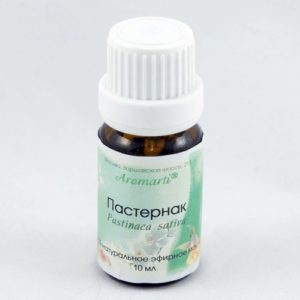
Parsnip essential oil has a number of beneficial properties: it has an antiseptic effect on the skin, dries up inflammation, and makes wrinkles less sharp. It is used as a remedy for anti-cellulite massage. Another method of application is in the fight against acne: in this case, acne moxibustion is used. This cauterization in moderation does not harm the skin.
The use of the root and leaves in cooking
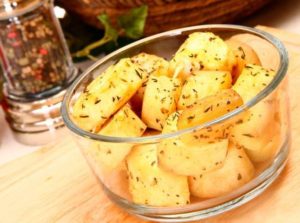
The results of research on the benefits and harms of parsnips have found their application in cooking, where the original vegetable has become an irreplaceable ingredient in various dishes and sauces. In this case, both its aboveground part and the rhizome are used.
The root is used in the preparation of first courses, as a side dish when stewing meat. It is also used both fresh - for salads, as well as preparations for the winter, or as a dried spice to add flavor to soups. An equally useful top - leaves - is also added to salads, stews and soups, fried meat.
Parsnip harm and contraindications

With all the undoubted advantages, the benefits of such a valuable plant as parsnip can easily turn into harm with individual intolerance to the components that make up the root crop.
A number of medical contraindications can also spoil the effect of eating healthy "white carrots". These include:
- severe urolithiasis;
- serious impairment of kidney function;
- severe disorders of the nervous system;
- increased sensitivity of the skin to the sun's rays: since the root vegetable is able to increase it even more, you can get a parsnip burn as a result, which will require treatment.
Harvesting and storage of useful culture

For harvesting parsnips, root crops that do not have traces of external damage are suitable.
The plant is harvested in late autumn, when the concentration of all healthy elements reaches a maximum. To do this, the roots are carefully dug in and taken out of the ground, sipping on the tops.
If you plan to store parsnips fresh, then you need to put them in the basement, in boxes with wet sand, so as not to harm the root crops.
You can dry the roots like this: cut each into strips and put on a baking sheet in the oven for 10 - 20 minutes at +50 degrees. The dried roots must be stored in a glass resealable container: then they will retain all their useful properties.
The stems and leaves are harvested during the flowering period. They are laid out in a thin layer on a thick cloth and dried in the open air. Store in resealable containers.
During the same period, you can collect parsnip seeds and, placing them in a dry glass jar, store in this way for 3 years: during this time they will not lose their useful properties.
Conclusion
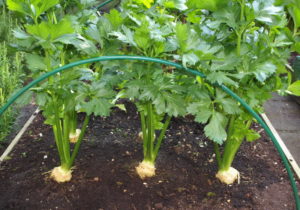
The benefits and harms of parsnips are a very delicate issue, since its properties can manifest themselves with different effects: both as a therapeutic effect on metabolism and the work of internal organs, and negative consequences - with weakened immunity, medical contraindications. In addition, with an increase in the concentration of the content of biologically active substances in the drug, the benefits of treatment can turn into harm.
Reviews


